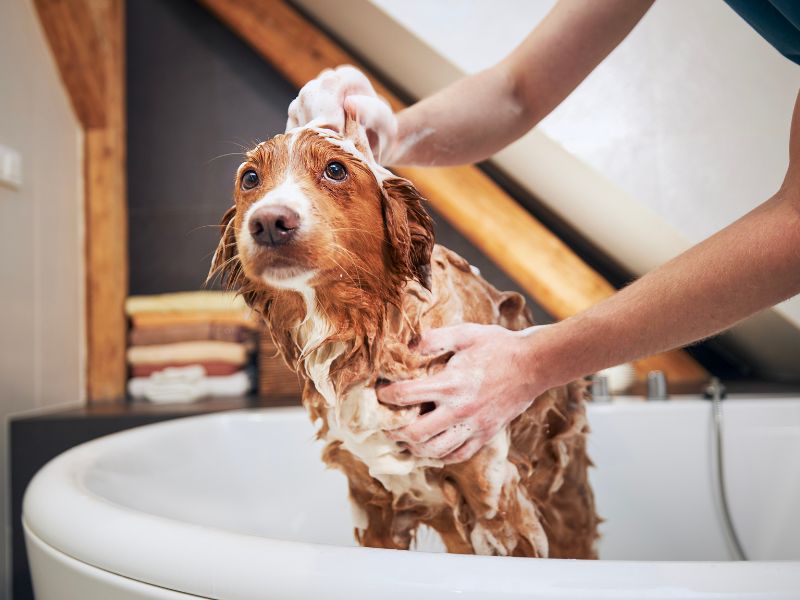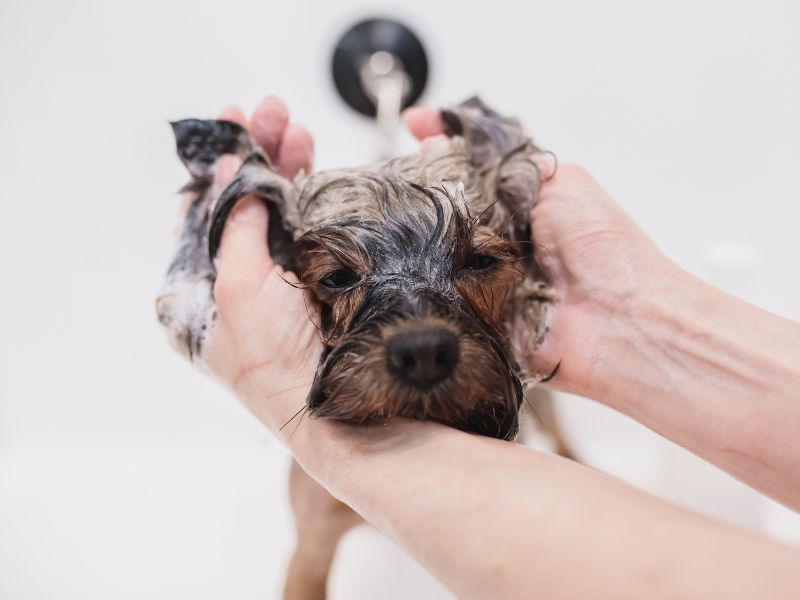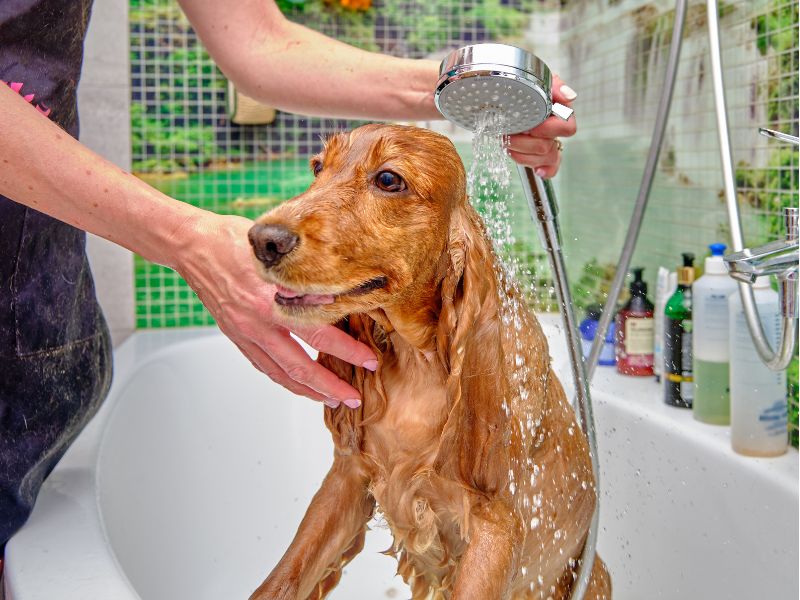Are you tired of buying different products for yourself and your furry friend? As a pet owner, you may have wondered whether you can use your own shampoo on your beloved dog. After all, it seems convenient and cost-effective. But is it safe? In this article, we will dive into the topic of using human shampoo on dogs and explore the potential risks and benefits. We will discuss the differences between human and canine skin, the pH levels, and the ingredients found in both types of shampoos. So, before you reach for that bottle of shampoo in your shower, join us as we unravel the truth behind using human shampoo on dogs. Let’s ensure your pup’s health and well-being are always a top priority!
Understanding the Difference Between Human and Dog Shampoo
When it comes to bathing our furry companions, it’s important to understand that human and dog shampoos are formulated differently for a reason. Dogs have a different pH level and a unique skin composition compared to humans. Human skin has a pH level of around 5.5, which is slightly acidic. On the other hand, dogs have a higher pH level, typically ranging from 6.2 to 7.5, which is more alkaline. This difference in pH levels is crucial when considering the use of human shampoo on dogs.
Additionally, the structure of a dog’s skin is different from ours. Dogs have a thinner epidermis, which is the outermost layer of the skin. This makes their skin more sensitive and prone to irritation. Human shampoos are designed to cleanse and condition human skin, which can be too harsh for the delicate nature of a dog’s skin. Using the wrong shampoo could disrupt the natural balance of oils on their skin, leading to dryness, itchiness, and other skin issues.
To ensure the well-being of your dog, it’s best to use a shampoo specifically formulated for dogs. These shampoos are made with ingredients that are safe and gentle on their skin, taking into account their unique pH level and skin structure.
The Importance of Using Dog-Specific Shampoo
Using a dog-specific shampoo is vital for several reasons. Firstly, these shampoos are formulated to maintain the natural balance of oils on a dog’s skin. They are designed to cleanse and condition without stripping away essential oils that help keep their skin and coat healthy. Human shampoos, on the other hand, can be too harsh and may strip away these oils, leading to dryness and irritation.
Secondly, dog shampoos often contain ingredients that target specific issues commonly faced by our furry friends. Whether it’s dry skin, allergies, or flea and tick prevention, dog-specific shampoos are tailored to meet their specific needs. They are formulated with ingredients that soothe and nourish their skin, providing relief from common skin problems.
Lastly, using a dog-specific shampoo can help prevent any potential adverse reactions. Human shampoos may contain ingredients that are safe for us but toxic to dogs. By using a shampoo specifically made for dogs, you can eliminate the risk of exposing your furry friend to harmful substances.

Potential Risks of Using Human Shampoo on Dogs
While using human shampoo on dogs may seem harmless, it can pose several risks. One of the main concerns is the difference in pH levels. As mentioned earlier, human skin is more acidic, while dogs have a more alkaline pH. Using a shampoo with a pH level that is not suitable for dogs can disrupt the natural balance of their skin, leading to irritation, dryness, and other skin issues.
Human shampoos may also contain harsh chemicals and fragrances that can be irritating to a dog’s sensitive skin. Ingredients like sulfates, parabens, and artificial fragrances are commonly found in human shampoos but can cause allergic reactions in dogs. These chemicals can strip away the natural oils on their skin, leading to dryness and itchiness.
Another risk to consider is the potential ingestion of the shampoo. Dogs often lick themselves after being bathed, and if they ingest the shampoo containing harmful ingredients, it can lead to digestive issues and even poisoning. Human shampoos are not formulated with the intention of being safe if ingested, making them unsuitable for use on dogs.
Ingredients to Avoid in Dog Shampoo
When choosing a dog shampoo, it’s important to be aware of the ingredients that can be harmful to your furry friend. Avoid shampoos that contain sulfates, such as sodium lauryl sulfate (SLS) or sodium laureth sulfate (SLES). These ingredients are commonly found in human shampoos as they create a rich lather, but they can be harsh and drying for a dog’s skin.
Similarly, parabens should be avoided as they have been linked to hormone disruption and can be harmful to dogs. Look for shampoos that are free from artificial fragrances, as these can cause allergic reactions and skin irritations.
Instead, opt for dog shampoos that contain natural and soothing ingredients like oatmeal, aloe vera, and chamomile. These ingredients help calm irritated skin, moisturize, and nourish the coat, promoting a healthy and shiny appearance.
Choosing the Right Dog Shampoo for Your Pet
With so many dog shampoos available on the market, it can be overwhelming to choose the right one for your pet. When selecting a dog shampoo, consider your dog’s specific needs. Does your dog have dry, itchy skin? Are they prone to allergies? Do they need a shampoo that helps with flea and tick prevention? Understanding their unique requirements will help you narrow down your options.
Read the labels carefully and look for shampoos that are specifically formulated for dogs. Check for natural ingredients and avoid shampoos that contain harsh chemicals, sulfates, parabens, and artificial fragrances. If your dog has any pre-existing skin conditions or allergies, consult with your veterinarian for recommendations on suitable shampoos.
Remember, what works for one dog may not work for another, so be prepared to try different brands and formulations to find the one that suits your furry friend best.
Proper Bathing Techniques for Dogs
Now that you understand the importance of using dog-specific shampoo, let’s discuss some proper bathing techniques. When bathing your dog, it’s crucial to use lukewarm water to avoid scalding their skin. Wet their entire coat thoroughly, taking care not to get water in their eyes, ears, or mouth.
Apply a small amount of shampoo to your hands and gently massage it into their coat, starting from the neck and working your way down to the tail. Be extra gentle around sensitive areas like the face, ears, and paws. Rinse thoroughly to ensure all the shampoo is removed, as any residue left on their skin can cause irritation.
After bathing, gently towel dry your dog and allow them to air dry completely before letting them outside or exposing them to cold temperatures. Brush their coat to remove any tangles and promote healthy circulation.

See Also: DIY Dog Toys and Accessories
And: The Best Ways to Exercise with Your Dog
Common Misconceptions About Using Human Shampoo on Dogs
There are several misconceptions surrounding the use of human shampoo on dogs. Some pet owners believe that using their own shampoo will save them money and time, without considering the potential risks involved. Others may assume that since their dog’s skin is covered in fur, it won’t make a difference if they use human shampoo.
However, these misconceptions can lead to serious consequences for your furry friend. Dogs have unique skin and coat requirements that differ from our own. Using human shampoo on dogs can disrupt the natural balance of their skin, leading to dryness, itchiness, and other skin problems. It’s essential to prioritize their well-being and invest in products specifically formulated for dogs.
Alternatives to Human Shampoo for Dogs
If you find yourself without dog shampoo and in need of a quick solution, there are a few alternatives you can consider. Baby shampoo can be a safer option compared to using human shampoo, as it is generally milder and gentler on the skin. However, it’s important to note that even baby shampoo is not ideal for long-term use on dogs.
Another alternative is to use a natural homemade dog shampoo. You can create a gentle shampoo by mixing a cup of water, a quarter cup of apple cider vinegar, and a few drops of mild dish soap. This mixture can help cleanse your dog’s coat while maintaining the natural pH balance of their skin. However, it’s always best to consult with your veterinarian before using any homemade remedies to ensure they are safe for your dog.
Tips for Maintaining Your Dog’s Coat and Skin Health
In addition to using the right shampoo, there are other ways to maintain your dog’s coat and skin health. Regular grooming is essential to keep their coat clean and free from mats and tangles. Brushing their coat helps distribute natural oils, promoting a healthy and shiny appearance.
Ensure your dog’s diet is balanced and provides the necessary nutrients for healthy skin and coat. A diet rich in omega-3 fatty acids, such as those found in fish oil, can help improve the condition of their skin and reduce inflammation.
Regular veterinary check-ups are also important to monitor your dog’s overall health and address any skin issues or allergies promptly. Your veterinarian can recommend specific shampoos or treatments tailored to your dog’s needs.
Conclusion
While it may be tempting to use your own shampoo on your dog for convenience, it’s important to prioritize their health and well-being. Using human shampoo on dogs can disrupt the natural balance of their skin, leading to dryness, irritation, and other skin problems. Dogs have unique skin and coat requirements that differ from ours, and it’s crucial to use products specifically formulated for them.
Investing in a dog-specific shampoo will help maintain the natural oils on their skin, address specific skin issues, and prevent potential allergic reactions. By understanding the differences between human and dog shampoos, you can make informed decisions when it comes to your furry friend’s grooming routine. Remember, their health and happiness should always be a top priority!

